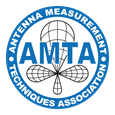Lars Jacob Foged,Andrea Giacomini, Antonio Riccardi, Roni Braun, Gennady Pinchuk, Marcel Boumans, Per Olav Iversen, November 2014
In Compact Antenna Test Range (CATR) applications, better cross polar discrimination is often the main motivation for choosing the more complex and expensive compensated dual reflector system as opposed to the simpler and cheaper single reflector system. Other than reflector geometry adjustment, different options have been presented in the literature to improve the cross polar performance of the single reflector CATR [1-4]. One solution is the insertion of a polarization selective grid between the feed and the reflector. The shape of the grids curved strip geometry is determined from the geometry of the reflector and each polarization has a different shape. This approach has been demonstrated to provide Quit Zone (QZ) cross polar performances similar to the dual reflector system on a decade bandwidth. The drawback of this solution is that orthogonal polarizations components cannot be measured simultaneously since a different polarizer grid is required for each polarization [1-2]. Other techniques aim at improving both amplitude/phase taper and cross polarization are based on measurement post processing. Processing techniques have been proposed based on numerical modelling of the range [3] or by de-convoluting the measured pattern with a predetermined range response based on QZ probing [4]. The drawback of these methods are the finite accuracy of the post processing, increased measurement complexity and the difficulty to measure active antenna systems. Recently, the application of conjugated matched feeds for reflector systems aimed at cross polar reduction in space application have received attention in the literature [5-10]. Recognizing, that the cross polar contribution induced by the offset reflector geometry has a focal plane distribution very similar to the higher order modes in feed horns, various techniques have been devised to excite compensating feed modes. Although a very elegant technique, the achievable bandwidth is limited and only single polarized solutions have been presented. A different concept of conjugated matched excitation, overcoming the dual polarization limitation has been introduced in [11-12] based on a patch array feed system. However, this implementation is aimed at applications with different beam-width in the principle planes. In this paper we will introduce a new feed horn concept, based on conjugate matched feeding, aiming at cross polar cancellation in single reflectors CATR systems. The proposed feed system is dual polarized and has an operational bandwidth of 1:1.5. The feed concept is introduced and the demonstrator hardware described. The target QZ <40dB cross polar discrimination is demonstrated by QZ probing of a standard single reflector CATR. References: [1] C. Dragone, "New grids for improved polarization diplexing of microwaves in reflector antennas," Antennas and Propagation, IEEE Transactions on , vol.26, no.3, pp.459-463, May 1978 [2] M.A.J. Griendt, V.J. Vokurka, “Polarization grids for applications in compact antenna test ranges”, 15th Annual Antenna Measurement Techniques Association Symposium, AMTA, October 1993, Dallas, Texas [3] W. D. Burnside, I. J. Gupta, "A method to remove GO taper and cross-polarization errors from compact range scattering measurements," ANTENNAS AND PROPAGATION SOCIETY INTERNATIONAL SYMPOSIUM (APSURSI), June 1989, San Jose, California [4] D. N. Black and E. B. Joy, “Test zone eld compensation,” IEEE TRANSACTIONS ON ANTENNAS AND PROPAGATION, vol. 43, no. 4, pp. 362–368, Apr. 1995. [5] K. K. Shee, and W. T. Smith, “Optimizing Multimode Horn Feed Arrays for Offset Reflector Antennas Using a Constrained Minimization Algorithm to Reduce Cross Polarization”, IEEE TRANSACTIONS ON ANTENNAS AND PROPAGATION, VOL. 45, No. 12, December 1997, pp. 1883-1885. [6] S. B. Sharma, D. Pujara, Member, S. B. Chakrabarty,r. Dey, "Cross-Polarization Cancellation in an Offset Parabolic Reflector Antenna Using a Corrugated Matched Feed", IEEE ANTENNAS AND WIRELESS PROPAGATION LETTERS, VOL. 8, 2009, pp. 861-864. [7] S. B. Sharma, D. A. Pujara, S. B. Chakrabarty, and V. K. Singh, “Improving the Cross-Polar Performance of an Offset Parabolic Reflector Antenna Using a Rectangular Matched Feed”, IEEE ANTENNAS AND WIRELESS PROPAGATION LETTERS, VOL. 8, 2009, pp. 513-516. [8] S. K. Sharma, and A. Tuteja, “Investigations on a triple mode waveguide horn capable of providing scanned radiation patterns”, ANTENNAS AND PROPAGATION SOCIETY INTERNATIONAL SYMPOSIUM (APSURSI), July 11-17, 2010 [9] K. Bahadori, and Y. Rahmat-Samii, “Tri-Mode Horn Feeds Revisited: Cross-Pol Reduction in Compact Offset Reflector Antennas”, IEEE TRANSACTIONS ON ANTENNAS AND PROPAGATION, VOL. 57, No. 9, September 2009. [10] Z. Allahgholi Pour, and L. Shafai, “A Simplified Feed Model for Investigating the Cross Polarization Reduction in Circular- and Elliptical-Rim Offset Reflector Antennas”, IEEE TRANSACTIONS ON ANTENNAS AND PROPAGATION, VOL. 60, No. 3, March 2012, pp. 1261-1268. [11] R. Mizzoni, G. Orlando, and P. Valle, “Unfurlable Reflector SAR Antenna at P-Band”, Proc. of EuCAP 2009, Berlin, Germany. [12] P. Valle, G. Orlando, R. Mizzoni, F. Heliere, K. van ’t Klooster, “P-Band Feedarray for BIOMASS”, Proc. of EuCAP 2012, Prague, Czech Republic.
